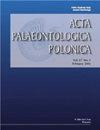美国犹他州上侏罗统莫里森组的一具摩根齿兽(哺乳动物目)
IF 1.9
3区 地球科学
Q2 PALEONTOLOGY
引用次数: 1
摘要
我们描述了来自Cisco哺乳动物采石场(上侏罗纪莫里森组)的一个新的morganucodontan的两个头骨碎片,以极好的3D细节保存了部分上颚和鼻子以及完整的上犬齿。Morganucodontans最为人所知的是来自威尔士和中国下侏罗纪的几个morganucodondon物种的孤立元素和相对完整的头骨;这个群体是我们理解哺乳动物早期进化的基础。ciscoensis . et sp. 11 .具有衍生的鼻部特征与臼齿的半形结构配对;远端前磨牙是复杂的,有一个非常低的计数(两个)的强烈叠瓦磨牙。这一特征组合扩大了这一群体的颅齿变异。我们从思科哺乳动物采石场采集泥岩样本进行灰落锆石分析,得到了151.50±0.28 Ma的年代。这将该地区的年代确定为最早的泰桑期,比莫里森组中其他主要哺乳动物生长的地区略年轻。Cifellilestes代表了这个群体中最年轻的成员之一,并将北美morganucodontans的记录延长了30多万年。Morganucodontans是晚侏罗世动物群中罕见的组成部分,但通过牙齿数量和齿尖形态的变化显示出令人惊讶的牙齿多样性,这是一种深度保守的、广泛的哺乳动物牙齿模式,这在至少80年前的巴西齿类(非哺乳动物)祖先中完全建立起来的。mororganucodonta,齿列,侏罗纪,Morrison组。本文章由计算机程序翻译,如有差异,请以英文原文为准。
A morganucodontan (Mammaliaformes) from the Upper Jurassic Morrison Formation, Utah, USA
A morganucodontan mammaliaform from Morrison We describe two skull fragments of a new morganucodontan from the Cisco Mammal Quarry (Upper Jurassic Morrison Formation), preserving portions of the palate and snout in excellent 3D detail as well as the complete upper postcanine dentition. Morganucodontans are best known by isolated elements and relatively complete skulls of several species of Morganucodon from the Lower Jurassic of Wales and China; this group is fundamental to our understanding of the early evolution of mammals. Cifellilestes ciscoensis gen. et sp. nov. possesses derived features of the snout paired with plesiomorphic construction of the molars; the distal premolars are complex and there is an unusually low count (two) of strongly imbricated molars. This character combination expands craniodental variation for the group. We sampled mudstone from the Cisco Mammal Quarry for ash-fall zircon analysis and obtained a date of 151.50 ± 0.28 Ma. This dates the locality to the earliest Tithonian and slightly younger than other major dated mammal-bearing localities in the Morrison Formation. Cifellilestes represents one of the youngest members of this group and extends the record of morganucodontans in North America by more than 30 Ma. Morganucodontans are a rare component of Late Jurassic faunas but display surprising dental diversity through variations in a tooth count and cusp morphology of a deeply conserved, generalized mammalian tooth pattern, which was fully established in brasilodontid (non-mammalian) ancestors at least 80 my prior. Morganucodonta, dentition, Jurassic, Morrison Formation.
求助全文
通过发布文献求助,成功后即可免费获取论文全文。
去求助
来源期刊

Acta Palaeontologica Polonica
地学-古生物学
CiteScore
2.80
自引率
5.60%
发文量
36
审稿时长
12.5 months
期刊介绍:
Acta Palaeontologica Polonica is an international quarterly journal publishing papers of general interest from all areas of paleontology. Since its founding by Roman Kozłowski in 1956, various currents of modern paleontology have been represented in the contents of the journal, especially those rooted in biologically oriented paleontology, an area he helped establish.
In-depth studies of all kinds of fossils, of the mode of life of ancient organisms and structure of their skeletons are welcome, as those offering stratigraphically ordered evidence of evolution. Work on vertebrates and applications of fossil evidence to developmental studies, both ontogeny and astogeny of clonal organisms, have a long tradition in our journal. Evolution of the biosphere and its ecosystems, as inferred from geochemical evidence, has also been the focus of studies published in the journal.
 求助内容:
求助内容: 应助结果提醒方式:
应助结果提醒方式:


